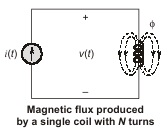Magnetic Coupled Circuits
INTRODUCTION
Whenever current flows through a conductor whether as ac or dc, a magnetic field is generated about that conductor. In the context of circuit, we often refer to the magnetic flux through a loop of wire. When a time varying magnetic field is generated by one loop penetrates a second loop, a voltage is induced between the ends of the seconds loop, a voltage is induced between the ends of the second wire. It means when two loops with or without contacts between them affect each other through the magnetic field generated by any one of them, they are said to be magnetically coupled.
SELF INDUCTANCE
Let us consider an inductor, with N turns in figure shown below. When current ‘i’ flows through the coil a magnetic flux φ is produced around it.
According to Faraday’s law, the voltage ‘v’ induced in the coil is proportional to the number of turns N and the time rate of change of the magnetic flux φ, that is,

v(t)= N (dφ/dt)
But the flux φ is produced by current ‘i’ so that any change in φ is caused by a change in the current.
Hence, equation can be written as,
v(t)= N (dφ/di) di/dt
which is the voltage current relationship for the inductor, where the passive sign convention is assumed.
The physical basis for such a current voltage characteristic rests upon two things:
- The production of magnetic flux by a current, the flux being proportional to the current in linear inductors.
- The production of a voltage by the time varying magnetic field, the voltage being proportional to the time rate of change of the magnetic field or the magnetic flux.
- The inductance L of the inductor is thus given by
- This inductance is commonly called self inductance, because it relates the voltage induced in a coil by a time varying current in the same coil.

